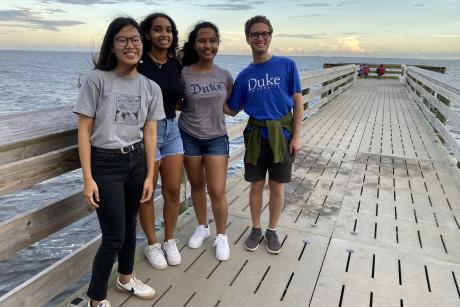
After consenting to be interviewed as a part of our project, Maya Pop’ti women agree to be photographed with the Guatemala SRT Team. Photo by Dr. David Boyd.
Published May 19, 2013, last updated on October 5, 2017 under Voices of DGHI
By Roxana Martinez
Imagine walking two to three miles just to get the most essential substance that your body needs: water. Imagine doing this daily, sometimes several times a day, while the sun is making your skin vulnerable to damaging rays, and while the exercise is steadily draining your energy and dehydrating you in the process of walking up and down steep hills. Imagine doing this with small rubber flats instead of proper sneakers with grips beneath them so that you don’t slip in the rocky dirt road, a road in which cars are continually passing by. Imagine doing this with one child on your back, one in your belly that you may not even know of yet, and with two or three of your other children or grandchildren trailing behind you because they are too young to stay home alone, or because they themselves are carrying a jug of water on their head like yourself. Imagine doing this after having woken up at 6 AM, made tortillas and coffee because there is nothing else to eat, fed your husband, children, and parents, and dressed the family for the day’s work ahead.
In Mayan culture, this is the role of the woman. Our whole team had already become aware of the gender inequalities that we would face in this community (via our weekly meetings with Dr. Boyd, Global Health classes, etc.), but it is another thing entirely to see that inequality so bluntly right in front of our eyes, five steps ahead of us, but a whole culture away. First and foremost, you see the inequality in who is carrying the children (and not just physically). Consistently, we have seen women carrying children on their back in a typical Mayan fashion. The baby or child is first placed on the back, which is followed by placing the middle of a long scarf-like fabric over the child and finished by tightly tying the rest of the fabric by the chest. I’ve been here for one whole week and have yet to see a male figure carrying a child in that way; at most, we saw one holding a toddler by his hand. As for pregnancies, there’s a plethora of them. In our first meeting with the comadronas of Concepción Huista, we met a midwife that had given birth to 24 children, 4 of which had died. In a community where condoms are too expensive to buy or any sort of “unnatural” birth control is not the norm (i.e., Mayan women typically use natural herbs to have abortions), having 24 children is not so unexpected. The physical stress of multiple, back-to-back pregnancies and potential emotional trauma of losing children so casually intertwine themselves to make the very unique suffering of a woman in this culture.
From these physical and emotional vulnerabilities emerges a certain kind of machismo. In our meeting with the traditional healers, one could see the healing bruise beneath the eye of one midwife, and facial scars and indents amongst the faces of a few other women. The remnants of domestic violence were present even in a meeting with so good an intention: to get their consent and understanding of the interviews that we’d later be doing with them. The high prevalence of domestic violence may be due in part because of how machismo manifests itself into something as disastrous as alcoholism. It is safe to conclude that alcoholism exists here exclusively amongst men. Once or twice we’ve seen men asleep on the side of the road, not because they had nowhere to sleep (and even if that was the case, who would choose a busy road?), but because they were so drunk that they themselves had no idea where they were. Or they had no idea how they got there at all. Or that their wife was still collecting water, taking care of the children, preparing meals, cleaning clothing, all with a hurry and diligence so that she could come and sit by her drunken husband by the road until he was sober enough to wake up and go home.
Only two male traditional healers were present in the two meetings we’ve had in the lower and higher parts of Concepcion Huista (lower and higher literally pertaining to altitude). Both men knew Spanish, unlike the majority of comadrona present at the meeting that only knew Pop’ti, and both were part of the more outspoken ones at the meetings. Many of the women at the meeting deliberately avoided eye contact, were very shy and showed very little (if any) facial expression when receiving their goody bags of soap, toothpaste, and a toothbrush. A slightly less obvious observation is that while the vast majority of men have transitioned to wearing “American” clothing, some women remain wearing traditional Mayan clothing (I almost wonder if this in itself is a form of you-can’t-take-away-my-culture-and-tradition resistance to one of the many pressures these women face – who knows?).
Despite the inequalities and sexism these women inadvertently face, these women have agreed to help us. They attended our general/introductory meetings with the traditional healers of the communities, some with no shoes, some with scars and bruises, some with empty stomachs, and some with children. With written signatures or with fingerprints, they agreed to allow us into their homes for interviews, which is a huge step for a culture that usually has the woman asking her husband for permission for such a thing. I don’t know how long change takes, but I can tell that something great is happening.


